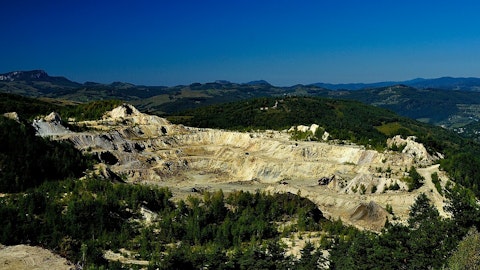In this piece, we will take a look at the ten worst performing commodities in 2023. If you want to skip our analysis of what’s been happening in the commodity markets over the past year, then head on over to 5 Worst Performing Commodities in 2023.
While the stock market is often the most widely covered by the financial press due to the glitz and glamor surrounding multi billion dollar firms and its ability to make founders into billionaires, there are other markets that are equally important to the global economy as well.
One such market is the commodities market. This market came into the spotlight last year after the Russian invasion of Ukraine. As a primer, the commodities market is made of products such as oil, wheat, coal, gold, and other natural resources. These form the backbone of global industrial production and energy needs as they are used either to power up machines or build products such as computers, electronics, and batteries. Not to mention, wheat is the world’s staple food and its prices are closely linked to inflation in several countries.
Therefore, it’s unsurprising that the commodities trade itself is quite lucrative. Data from the United Nations shows that global commodity exports were worth $4.39 trillion by the end of 2019 as they marked a 20% growth over the values a decade ago in 2009. At the same time, the market remained roughly the same, with the same countries that had imported commodities in 2009 continuing to do so ten years later. Most of these countries are developing countries and a lot of these countries also depend on these imports for their exports as local conditions are either unsuitable for growth or are undeveloped to meet the needs of export-oriented industries.
Research and consulting firm McKinsey takes a look at the value that commodity trading pools over the years to understand the sector’s growth. For the uninitiated, a commodity trading pool is a collection of investor funds that allows them to trade in different markets for the sector. These markets include options, futures, and more. McKinsey’s data shows that total trading operating incomes from commodity pools made of oil, power, gas, metals, and agricultural products stood at $29 billion in 2017. From the looks of it, it appears as if this sector was one of the few that actually grew in value during the coronavirus pandemic since between 2019 and 2020 the trading pool added $17 billion in value. This growth continued in 2021, for a final value of $52 billion which marked a 1.7x growth over the 2019 figures. McKinsey adds that not all commodities are created equal, since a shift in global demand and supply dynamics that has seen a growing demand for metals such as lithium for batteries grow and a reduction in investment in hydrocarbon exploration led to uncertainty about oil supply in the future. Finally, a key aspect of the Russian invasion of Ukraine has been greater inefficiencies in the oil supply chain since ships now spend more time at sea than they would have if global geopolitics were not in play.
Moving towards the commodities trading industry, it is made of several large players that have a sizeable impact on the way prices are set for commodities such as cotton. Some of the biggest commodity trading companies in the world are Glencore plc (LON:GLEN.L), Vitol, and Trafigura and these firms reported bumper profits in 2022 after the global commodities shock due to Russia’s Ukraine invasion. However, they received lower coverage in the media than the oil companies, and just as has been the case with the oil companies, the three firms are also seeing revenues drop significantly this year as global commodities prices drop.
Out of the commodity traders, Glencore, which reported its second quarter earnings at the start of August outlined that its operating income for the first half of 2023 had dropped by 50% to $9.7 billion. This drop, according to the company, was fueled by global coal prices coming off of record highs as the energy supply chain stabilizes in 2023. Coal prices had soared last year as it was chosen as a last resort alternative by countries struggling to control inflation from a jump in oil and gas prices.
Another major player in the global commodities market, particularly in the minerals sector is the Australian mining giant Rio Tinto Group (NYSE:RIO). The firm’s profit for H1 2023 dropped by 43% as it struggled to keep up with a slowdown in the Chinese economy. China is one of the fastest growing economies in the world which makes it import copious amounts of metals for products such as wires. An economic slowdown reduces this demand and mining firms naturally suffer as a result. If you are interested in finding out more details about the basic materials sector which primarily deals with commodities, then head on over to 13 Best Basic Materials Stocks to Buy Now.
As to the current state of the mining market, here’s what the management of Vale S.A. (NYSE:VALE) had to say during the firm’s latest earnings call conference:
As you can see, we delivered an EBITDA of $4.1 billion, $1.4 billion below the same period in 2022. This decrease is explained by $15 per ton lower iron ore fines realized price and by the $3,000 per ton lower nickel realized prices, following the decline in the reference prices since second quarter 2022. The impact of cost and expenses on EBITDA was relatively small at $96 million, mainly from transitory effects in the nickel business related to the maintenance and higher third-party nickel feed purchases.
In iron ore and copper, despite the year-on-year inflationary pressure, costs and expenses improved EBITDA by $218 million. I will go into more details on costs later in my presentation. Sales volumes and by-products helped increase our EBITDA by $154 million as a result of initiatives to improve asset reliability, and we expect to continue seeing these positive results in the second half of 2023. Now on to iron ore costs.

Photo by Adi Goldstein on Unsplash
Our Methodology
To compile our list of the worst performing commodities in 2023, we used data from the commodities investment product manager U.S. Global Investors to sift out commodities that have had the greatest negative returns in percentage terms during the first half of 2023. The final list of the worst performing commodities in 2023 is as follows.
10 Worst Performing Commodities in 2023
10. Platinum
Returns During H1 2023: -6.45%
Platinum is one of the most valuable metals in the world and one which gives the world’s most precious metal, gold, a run for its money. However, since platinum is not as popular as gold as the material of choice for jewelry and other precious objects, gold prices are often higher than platinum prices. The demand for platinum comes primarily from industry, particularly due to its usage in catalytic converters that remove harmful emissions from car exhaust fumes. Platinum is also used in laboratories and other use cases due to its chemical properties.
9. Corn
Returns During H1 2023: -6.53%
Corn is one of the world’s staple foods. It originated in Mexico thousands of years ago, and naturally, it is also used in a variety of Mexican foods such as tortillas and tacos. The U.S. was the world’s largest corn producer in 2020, as it churned out 360 million tons of the commodity. Within America, Iowa is the country’s largest corn producer as it accounted for 18% of America’s corn production in 2022. Research estimates show that the global corn market is slated to sit at 1.6 billion metric tons by 2027 end after a compounded annual growth rate (CAGR) of 5.3% from 2022.
8. Lead
Returns During H1 2023: -8.31%
Lead is one of the more controversial commodities on our list. This is due its heavy usage in gasoline for anti knocking effects in the late 1900s. Unknown at the time, lead fumes cause severe birth abnormalities and are a significant health hazard, especially to young kids. China is the world’s largest lead producer, as it produced a massive two million metric tons in 2021. The global lead market is expected to sit at $19 billion by the end of this year, and most use cases in America revolve primarily around using the metal for manufacturing batteries.
7. Copper
Returns During H1 2023: -14.56%
Copper, like oil, is the backbone of modern day economic growth. Copper is the metal of choice when making wires that go in nearly every modern day convenience, such as a house, a car, a phone, a laptop, and others. Naturally, its prices typically correlate with global economic growth prospects, since higher growth leads to more demand for industrial and electrical products. Chile is the world’s largest copper producer, and countries that rely primarily on the metal for their exports often see their economic condition rise and fall with the metal’s demand.
6. Wheat
Returns During H1 2023: -17.45%
Wheat, which is another staple food, was one of the most widely discussed commodities last year. This was due to Russia’s invasion of Ukraine, which made the global market quite precarious as both countries are among some of the largest exporters of the commodity. China is the world’s largest wheat producer, having churned out 138 million metric tons in 2022.
Click to continue reading and see 5 Worst Performing Commodities in 2023.
Suggested Articles:
- 11 Stocks with Heavy Insider Buying
- 10 Best Coal Mining Stocks to Buy
- 20 Countries with the Highest Wheat Consumption
Disclosure: None. 10 Worst Performing Commodities in 2023 is originally published on Insider Monkey.





